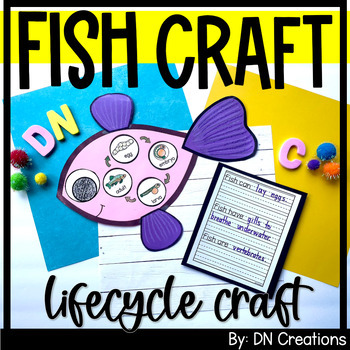Fish Life Cycle Craft | Fish Science Craft | Fish Craft
DN Creations
666 Followers
DN Creations
666 Followers
What educators are saying
These came out so cute! My students loved making their fish and showing off their knowledge of the life cycle.
So cute! Perfect addition for fish unit. My students enjoyed making these. Very pleased with my purchase.
Description
This sequencing Fish Life Cycle craft is a perfect add to your Ocean Science unit. This fish craft includes differentiated writing templates to use for informative writing on fish facts and opinion writing on "if I were a fish, I would...". Try this animal craft for a cute science classroom wall decoration for an ocean themed open house! They are simple enough for preschool and Kindergarten science crafts. Learn about the fish lifecycle with this underwater animal life stage craft!
Check out other resources in my store!
- !!FREEBIES!!
- PPT or Google Slides Products
- LITERACY Products
- SCIENCE Products
- HOLIDAY Products
- BIBLE Products
Please follow me @DN Creations to stay updated on new products and sales!
Total Pages
16 pages
Answer Key
Included
Teaching Duration
N/A
Report this resource to TPT
Reported resources will be reviewed by our team. Report this resource to let us know if this resource violates TPT’s content guidelines.
Standards
to see state-specific standards (only available in the US).
NGSS1-LS1-1
Use materials to design a solution to a human problem by mimicking how plants and/or animals use their external parts to help them survive, grow, and meet their needs. Examples of human problems that can be solved by mimicking plant or animal solutions could include designing clothing or equipment to protect bicyclists by mimicking turtle shells, acorn shells, and animal scales; stabilizing structures by mimicking animal tails and roots on plants; keeping out intruders by mimicking thorns on branches and animal quills; and, detecting intruders by mimicking eyes and ears.
NGSS1-LS1-2
Read texts and use media to determine patterns in behavior of parents and offspring that help offspring survive. Examples of patterns of behaviors could include the signals that offspring make (such as crying, cheeping, and other vocalizations) and the responses of the parents (such as feeding, comforting, and protecting the offspring).
NGSS3-LS4-3
Construct an argument with evidence that in a particular habitat some organisms can survive well, some survive less well, and some cannot survive at all. Examples of evidence could include needs and characteristics of the organisms and habitats involved. The organisms and their habitat make up a system in which the parts depend on each other.
NGSS2-LS4-1
Make observations of plants and animals to compare the diversity of life in different habitats. Emphasis is on the diversity of living things in each of a variety of different habitats. Assessment does not include specific animal and plant names in specific habitats.
NGSSK-LS1-1
Use observations to describe patterns of what plants and animals (including humans) need to survive. Examples of patterns could include that animals need to take in food but plants do not; the different kinds of food needed by different types of animals; the requirement of plants to have light; and, that all living things need water.





